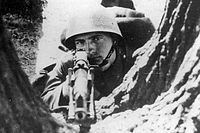Dates 9 Sep 1939 – 2 Oct 1939 | Result German victory | |
 | ||
38,000 infantry2 pre-dreadnoughts2 destroyers 2,80046 guns1 destroyer1 minelayer1 patrol boat Similar Invasion of Poland, World War II, Battle of Tuchola Forest, Battle of Kępa Oksywska, Battle of Szack | ||
Total war warhammer legendary vampire counts ep 06 battle of hel fenn
The Battle of Hel was one of the longest battles of the Invasion of Poland during World War II.
Contents
- Total war warhammer legendary vampire counts ep 06 battle of hel fenn
- Total war warhammer quest battle battle of hel fen legendary
- Prelude
- Battle
- Aftermath
- References
The Hel Peninsula, together with the town of Hel, was the pocket of Polish Army resistance that held out the longest against the German invasion. Approximately 2,800 soldiers of the Fortified Region Hel unit (Helski Rejon Umocniony), part of the Coastal Defence Group (Grupa Obrony Wybrzeża) under Włodzimierz Steyer, defended the area against overwhelming odds from 9 September until 2 October 1939, when they surrendered.[1]
Total war warhammer quest battle battle of hel fen legendary
Prelude
There was a Polish military port in Hel from 1928, and the Polish military had been in control of the northern part of the peninsula since the 1920s. In 1936 the northern section of the Hel peninsula was officially named the Hel Fortified Area (Helski Rejon Umocniony). Approximately 2,800 soldiers were stationed in the area, and the Fortified Region included three coastal (anti-ship) and anti-air gun batteries. The coastal batteries were divided into one 4 × 152 mm battery, two older 2 × 105 mm batteries and three batteries with 8 × 75 mm guns in total. Anti-air batteries had 6 × 75 mm and 8 × 40 mm guns, and two 120 cm searchlights.
Battle
Hel was the target of Luftwaffe air attacks from the first day of the invasion (1 September). The German army forced Polish units of Armia Pomorze to retreat from the Danzig Corridor in the first week of September, and began the assault on the Polish forces in Hel on 9 September. After Armia Pomorze was defeated in the Battle of Tuchola Forest, and other Polish strongholds on the coast capitulated (Battle of Westerplatte, Battle of Gdynia and Battle of Kępa Oksywska), from 20 September onward Hel was the only viable pocket of Polish resistance in northern Poland.
Hel defenders damaged a German destroyer on 3 September. Two German Kriegsmarine destroyers were damaged by Hel gunfire, and gunfire from the Polish destroyer Wicher and minelayer Gryf on 3 Sept. The Luftwaffe then sank the two Polish ships.
Several Polish light minelayers laid a minefield near Hel in the night of 12 and 13 September. After some of the Polish ships were sunk by the Luftwaffe on the following day, and due to German control of the Baltic Sea, the remaining Polish naval units docked at Hel port and their crews joined the ground forces. The ships' armaments were stripped and converted into additional land gun emplacements. German naval units, including old battleships Schleswig-Holstein and Schlesien, shelled the Hel peninsula from 18 September, but with little effect. Schleswig-Holstein was lightly damaged by Polish coastal batteries on 25 September. Hel anti-aircraft batteries proved to be extremely efficient, shooting down between 46 and 53 German aircraft during the battle.
By 14 September Polish forces on the Hel peninsula were cut off from the mainland. After initially being stalled by Polish defences, the Germans brought land artillery batteries and an armored train battery to support their barrage. German forces slowly advanced, although they were still facing significant resistance and counterattacks. On 25 September, after the Germans took the village of Chałupy (today part of the town of Władysławowo), Polish military engineers detonated a number of torpedo warheads in the narrowest part of the peninsula, and for a time separated the peninsula from the mainland, transforming it into an island. On 1 October, the commander of the Polish Navy, counter-admiral Józef Unrug, taking into consideration that the outpost was running out of supplies and that no relief force would be coming, gave the orders to capitulate. The Germans occupied the peninsula by 2 October. After the capitulation of Hel, the only organized Polish resistance was carried out by Independent Operational Group Polesie, which eventually capitulated at the end of the Battle of Kock.
Aftermath
One of the four 152 mm Bofors batteries on Hel is now on display at the Armed Forces Museum in Warsaw.
